HD681
back to Superlux
back to measurements
home
Published: May-15-2013, updated: Jan-2-2019
NO SMOOTHING is applied to the shown plots. Most measurement sites have some smoothing applied which ‘irons flat’ sharp peaks and ‘wiggles’. I do not use smoothing because some info about sound quality is lost when plots are smoothed.
Aside from a small correction of the microphone itself also some correction in the lowest frequencies is applied to the plots to compensate for the perceived loss of bass when using headphones. This is described HERE in more detail.
A ‘horizontal‘ frequency response curve on the shown frequency response plots on this website thus indicates a perceived ‘flat’ tonal signature.
ALL measurements are made with a good SEAL on a flatbed measurement rig.
The shape of your head, bone structure, pad size, pad ‘softness, (compliance), hair or no hair and or wearing glasses may (drastically) change the frequency response of some headphones, so… your personal experience may differ substantially from these plots.
Frequency response (tonal balance) is the most sound-determining aspect of headphones. A horizontal line shows audible neutral response in the plots on this website. Deviations in different severities at different frequency bands have an effect on the sound character.
The bigger the deviation the stronger the effect.
Below an aid to help determining the sound character of headphones with relation to the frequency response.

Superlux HD681
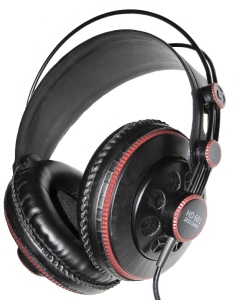
Above the current (2018) HD681 which is sold for over 10 years now. In that time it seems to have undergone some changes on the outside and it seems also slight changes on the inside as well. Below an early version (on the left) and a 2018 version (on the right). The red rings have been changed from bright red to a dark red. The print on the headphones has changed as well. The cable and construction as well as the driver and the pads appear to be the same.
The red rings have been changed from bright red to a dark red. The print on the headphones has changed as well. The cable and construction as well as the driver and the pads appear to be the same.
The components that tend to break over time (the plastic bit that couples the rods to the headphone) is unchanged alas. The pads also could have been changed instead of cosmetics only.
Comfort wise these aren’t that great and they feel a bit cheap. That may be because they are really cheap. They sell for € 19.- to € 25.- which is a bargain.
One can bend the headphones in all directions which does contribute to the cheap feel. However, this is more of a feature (AKG copy) than because of the price.
The pads and headband are not comfortable. The pads are the stiffer pleather kind with a rather small depth. The headband is not padded but does not cause soar spots because of the light weight and low pressure.
Adjustability is good though and will fit most headsizes.
Clamping force is pleasant. Not too loose and not clamping hard.
specifications:
Type: over ear, semi-open
Usage: studio usage, home and portable
Driver type: dynamic
Pads: replaceable, pleather pads
Inner pad dimensions: diameter = 55mm, depth = 15mm
Collapsable: No.
Cable entry: single sided (Left)
Cable: fixed, 2.5m. with 3.5mm TRS jack and screw-on 6.3mm adapter.
Driver size: 50mm
Nom. power rating: 0.3W
Nom. voltage: 3.1 Vrms
Nom. current: 100 mA
Max. S.P.L. 122 dB
Impedance: 32 Ω
Efficiency: 98 dB @ 1mW
Sensitivity: 113 dB @ 1V
Isolation: medium (semi-open)
Weight: 276 g.
Clamping force: low
Accessories: 6.3mm TRS adapter, pouch.
Sound description:
This headphone is quite bassy and reaches down very deep. The bass does not bleed into the mids.
The mids themselves are clear and open sounding but not ‘refined’ they have a coarseness about it, especially at higher levels. There is good clarity/presence.
The treble is .. well… elevated and can sound harsh and filled with ‘fake detail’.
For its price it does not sound bad at all and it has the potential to sound a lot better with some modifications. Alas that requires some soldering.
Below the FR plot of the 2018 Superlux HD681 in stock form (pleather pads) Right, Left.
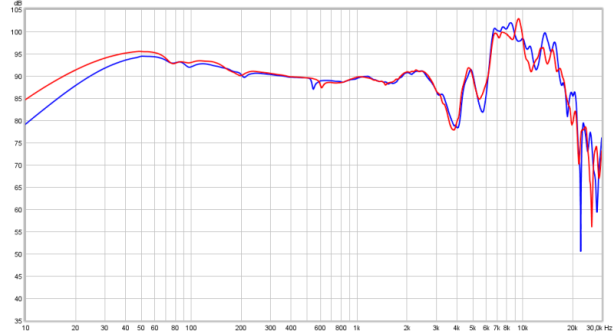 Bass extension is excellent. The bass is somewhat raised (+5dB) which some will like and others may find over the top. There is a slight imbalance below 50Hz but this is not audible.
Bass extension is excellent. The bass is somewhat raised (+5dB) which some will like and others may find over the top. There is a slight imbalance below 50Hz but this is not audible.
The response is impressively flat (within 3dB) from 100Hz to 2.5kHz. Because of this the sound is very neutral and realistic. Around 4kHz there is a dip. It is narrow but not innocent.
The treble is raised. +10dB means it is reproduced 2x as loud as the bass to mids which is very audible.
For older folks (65+) this may be welcome, for the rest of the public it is a bit too much.
EQ or modifications can help greatly here.
To see if the sound has changed over the years as well below a 2011 HD681 versus the current (2018) HD681.
They certainly are quite similar from 10Hz to 1kHz. Above 1kHz there appear to be differences. The older version has more presence in the upper mids and treble.
The older version is a pit ‘shouty’ and too ‘forward’ in the mids. This makes the 2018 version (no idea when these small changes were made) more neutral.
seal
As the seal of this headphone is of importance (pads touching the skin everywhere) some experiments showing the effect of a loss of seal.
(Lots of) hair between the headphone and ear or headshape and (reading) glasses can break the seal and will affect the tonal balance.
Below: Perfect seal, a small seal breach caused by hair or thin armed (reading) glasses that sit just above the skin, glasses with thicker arms and a big seal breach (6.3mm plug). A small seal breach isn’t really problematic. In fact it is even welcome and makes the headphone a bit ‘more linear’ sounding. Even a substantial seal breach is not very problematic but the sound is a bit ‘thinner’ though.
A small seal breach isn’t really problematic. In fact it is even welcome and makes the headphone a bit ‘more linear’ sounding. Even a substantial seal breach is not very problematic but the sound is a bit ‘thinner’ though.
output resistance / damping-factor
As this is a dynamic headphone the frequency response might be amplifier output resistance dependent when certain higher output resistance amplifiers are used.
To test this the headphone is measured via a low impedance amplifier (0.2Ω) and a high impedance amplifier (120Ω).
On a higher output resistance amplifier the output level will be considerably lower. To compensate for this the amplifier is cranked up to the same level (14dB at 1kHz) as the low impedance amplifier. This way the plots are overlay-ed and it is easier to show the tonal balance differences.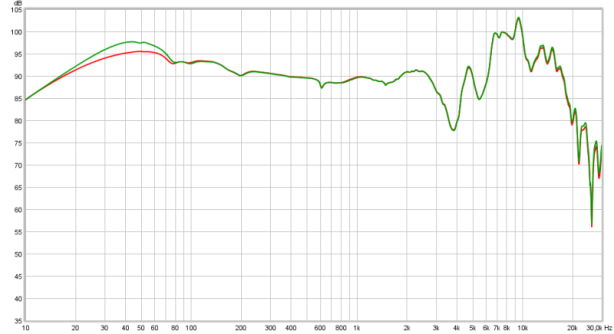 The headphone does not react that much to higher output resistances. There is about 2.5dB more subbass only. The rest remains unaffected. No reason to worry about output resistances with this headphone. The plot shows the resonance frequency of this driver is unusually low in frequency (around 40Hz) and quite narrow as well.
The headphone does not react that much to higher output resistances. There is about 2.5dB more subbass only. The rest remains unaffected. No reason to worry about output resistances with this headphone. The plot shows the resonance frequency of this driver is unusually low in frequency (around 40Hz) and quite narrow as well.
Below the distortion measurements of the HD681 (Right channel)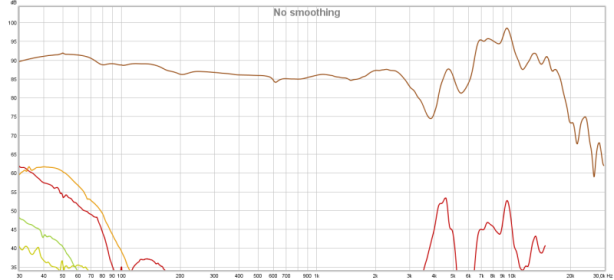
Below the same distortion plot but with the vertical scale in percentages instead of level differences.  The 3rd harmonic distortion around 40Hz is reaching 3.5% and is indicative of ‘clipping’ allike non-linear behaviour. From 120Hz up the distortion is well below 0.1%.
The 3rd harmonic distortion around 40Hz is reaching 3.5% and is indicative of ‘clipping’ allike non-linear behaviour. From 120Hz up the distortion is well below 0.1%.
Higher distortion levels at lower frequencies are not really that audible as such so everything below 1% is good. The distortion thus is somewhat on the high side. 2nd harmonic distortion in the lows is also on the high side 2% around 40Hz. Above 60Hz it drops below 1%.
The 2nd harmonic distortion is probably lower than shown, as limits of the test rig are around 0.15%.
The elephant in the room sticks out like a soar thumb though. There is something ‘wrong’ around 4kHz. This is also seen in the frequency plots as a dip. At that frequency the signal/distortion distance is only 25dB and thus reaching audible levels. As this is around a frequency where the ear is extra sensitive (ear canal resonance) this is audible as a slight ‘coarseness’ in the upper mids. A loss of ‘smoothness’ in the sound with certain recordings and can even sound ‘harsh.
Keep in mind it IS a cheap headphone after all.
Below the CSD of the HD681. (Left and Right are superimposed) The treble part is a bit ‘messy’ and aside from being elevated it shows a few (fortunately short lived) resonances above 4kHz.
The treble part is a bit ‘messy’ and aside from being elevated it shows a few (fortunately short lived) resonances above 4kHz.
Below the spectrum plot of the HD681 (Right channel). Around 600Hz and 1.5kHz there is some low level short lived ‘ringing’. At these levels (-45dB below the signal) they aren’t really problematic. 
The step response plot below (Right Channel) shows the impulse response from the 2011 and 2018 version. Both have substantial ringing that lingers on quite long. Bass extension is excellent as the horizontal line is hardly sloping downwards.
Both have substantial ringing that lingers on quite long. Bass extension is excellent as the horizontal line is hardly sloping downwards.
Superlux also sells velours (they call it velvet) pads for the HD681. This includes a set of foam discs. The order code: EPK681-V. These are not that expensive (around € 10.-).
A more expensive alternative are AKG K240 velours pads. I would stay away from Chinese replacement pads of e-bay etc. These sound substantially different and not for the better.
The velvet pads have a slightly smaller opening for the ears. The diameter is 50mm.
Depth is slightly better at 17mm.
Below the frequency response with stock pleather pads and with the velvet pads. Bass response isn’t changed. Mids are slightly lower in level (driver is a tiny bit further away from the ear). Treble response is inproved by a few dB and less ‘grainy’.
Bass response isn’t changed. Mids are slightly lower in level (driver is a tiny bit further away from the ear). Treble response is inproved by a few dB and less ‘grainy’.
Those finding the somewhat elevated bass a bit too much there is an easy to perform  modification that lowers the bass to more neutral territory.
modification that lowers the bass to more neutral territory.
It requires opening up the headphone. This is described in the modification manual and involves adding some 5mm thick open cell-foam over the hole in the magnet of the driver as shown on the right.
The openness of the foam (and thickness) will have an effect. Thicker foam = less bass, more dense foam = less bass.
Those not willing to open up the HD681 but are handy with a soldering iron can also use an electonic passive filter built into a small extension cord.
Below the effect of the foam covering the hole (both traces using the velvet pads). 
The bass response is no longer elevated and the response is impressively ‘flat’ between 20Hz and 6kHz (aside from the 4kHz dip) while retaining excellent subbass extension.
What still needs to be addressed is the treble response. One can do this in a passive way by adding toilet paper in front of the driver or some felt but this also lowers treble extension and dulls the sound. The best way for the HD681 is to use EQ or to build the notch filter described in the modification manual (downloadable pdf).
The effect of this filter with the foam modification and using the velvet pads is shown in the plot below. (left, right)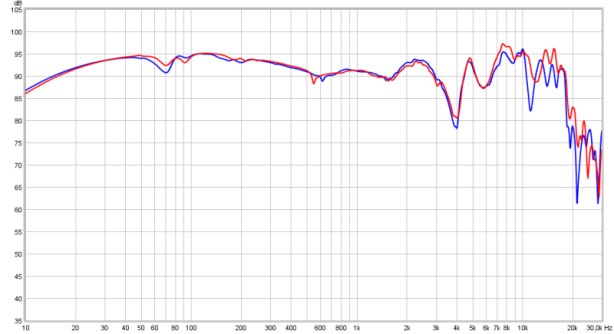
The HD681 has improved in tonal balance (very neutral/realistic) and comfort (pads) and is quite ‘flat’ from 15Hz to 19kHz within a few dB.
Below the modified HD681 (filter + foam on driver mod) but using the stock pleather pads versus the stock HD681 (pleather pads) left channel only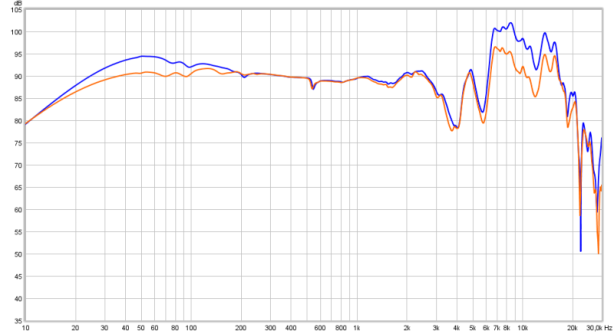
Below the difference between the stock HD681 (pleather pads) versus the modified HD681 (velvet pads, foam on driver, treble filter) right channel only The changes are quite audible. The bass modification (requiring opening the headphones) of coarse can be omitted and get a bit more lows in which case the green line (below 100Hz) will follow the red trace. To me the quality of the bass improved with the foam though.
The changes are quite audible. The bass modification (requiring opening the headphones) of coarse can be omitted and get a bit more lows in which case the green line (below 100Hz) will follow the red trace. To me the quality of the bass improved with the foam though.
The distortion plots did not change much due to these mods. The 4kHz issue is still there.
Impulse response improved. Below the step response of the original HD681 versus the modified HD681

summary
In stock form the HD681 is cheap but not very comfortable. It has a pleasantly raised bass with great extension. The treble is too much though and it sounds ‘sharp’ and can even be ‘grating/harsh’ with some recordings. It does not have smooth and soft treble.
Quality vs price is good but don’t expect a sturdy headphone that won’t break.
However, the velvet pads improve the comfort and sound.
The inline-filter removes the grating treble and while the headphone is not the most refined headphone around it still is quite enjoyable when modified. Certainly when not played very loud.
Lowering the bass is another option that improves its quality.
The extra pads (order them along with the HD681) and the electronic filter will of coarse add to the total costs and double the price. But despite the increase in costs it still has a high quality sound compared to the price. Modifications are highly recommended.
